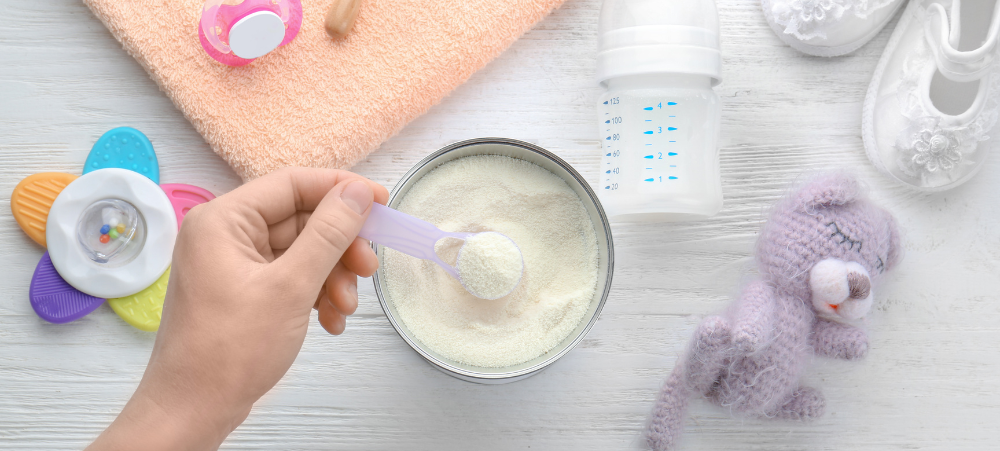You may have fluctuating emotions when it comes to introducing solids. You may eagerly wait that first mouthful and be pinning a lot of hope on solids getting your baby to sleep better, while at the same time feel sad as the realization dawns that your baby is growing up. Many mistruths and myths surround when to start solids, for example: It is not true that you must start solids as soon as your baby has doubled her birth weight or when she is drinking more than 1 litre of milk a day. Nor does it mean that your baby is hungry because she has her hands in her mouth all the time at 4 months of age. Furthermore, introducing solids will not guarantee that your baby will sleep through the night.
When solids are introduced too early, that is before 17 weeks of age, the immaturity of your baby’s digestive and immune system may increase her risk of developing an allergy. The exact ‘right’ age for your baby to begin eating solids will depend on two main factors: physical and emotional. Your baby needs to be both physically ready for food as well as emotionally ready. You will also have a sense whether or not your baby is ready to eat solids. Learn to trust this intuitive side of being a parent.
Physical factors indicating your baby is ready for solids:
- Between four and six months old
- Can hold her head up
- Sits comfortably with support
- No longer satisfied with her normal milk feeds even if volume is at an age appropriate level
- Is unsettled between feeds during the day and is decreasing the time between feeds to 3 hours or less
- Demands more frequent milk feeds at night or suddenly start waking closer to midnight again
- Weight gain may have slowed down
- The tongue – thrust reflex diminishes
Emotional factors
- Starts to show an interest in foods
- Watches you eat – social eating
- Turns her head towards you while you are eating
- Mirrors your mouth movements by opening her mouth in response to your eating
- Shows excitement when watching others eat
By 6 months it is critical to start introducing solids even if some of the physical or emotional factors are not obviously present. Babies are born with a store of nutrients. These are normally adequate for the first few months of life. Iron is an example of this. After the first 4-6 months your baby’s iron stores begin to deplete. Furthermore, milk is no longer an adequate sole source of iron and so you need to give your baby additional iron rich foods.
Foods to try between 4 – 6 months:
- First veggies: baby marrow, gem squash, sweet potato
- Orange vegetables: butternut, carrots, pumpkin, sweet potato, Hubbard squash, potato
- Green veggie mix – spinach, baby marrow, gem squash, peas, beans
- Fruits: Apples, pears, peaches, prunes, papino, avocado, banana, mango, melon
- Quinoa porridge
- Maize cereal
- Maltabella porridge
If you have introduced solids closer to 4 months then you will be able to introduce some protein foods just prior to 6 months.
A good time of day
Introduce the first solid meal at a time of day when your baby is happily awake, in the calm alert state. Choose a time of day when you are not stressed. The early evening is not always the most relaxed time in a household, especially if you have a busy toddler under foot. A good time is in the morning about half an hour after a milk feed and during ‘play time’. Making the first food experiences fun and stimulating will set the tone for many happy feeding times.
Week 1:
Day 1: gem squash, baby marrow and sweet potato (green veggie) mix. Steam or bake the above. Liquidize with additional water if necessary.
In the beginning blend or mash the food. Freeze in freezer containers in 3tsp quantities.
Day 1 – 3: Give 1 – 3tsp green veggie mix at midday at a happy awake time.
Day 4 – 7: Introduce a second veg group ; orange veggies: hubbard squash/butternut, carrots and parsnips/orange sweet potato mix. Give 1-3tsp orange veggie mix at midday and alternate with green veggie mix
Optional Tactile: allow your baby to touch and feel a veggie that you have left over from the night before while feeding the solid mix
Week 2
Day 1-7: Introduce a second meal at another happy time:
Eg: Meal 1 orange veggie mix 1-3tsp
Meal 2 green veggie mix 1-3 tsp
Optional Tactile: allow your baby to touch and feel a veggie that you have left over from the night before while feeding the solid mix
Week 3
Introduce a third meal of fruit
Choose: apple, pear, mango, peach, guava, prune, avocado, paw paw (in season fruit) you can mix 1-3 fruits together or give individually
Meal 1: fruit mix 1-3 tsp
Meal 2: Green or orange veggie mix 1-3tsp
Meal 3: Green or orange veggie mix 1-3tsp
Optional Tactile: allow your baby to touch and feel a veggie that you have left over from the night before, while feeding the solid mix
Week 4
Introduce porridge
Introduce a grain food: Ideally cook from scratch like oats, quinoa, millet, spelt, maltabella, maize porridge. If you need to use baby cereal choose one that is not full of sugar, soya, cows milk protein or other additives .
Soak 2 TBSP oats/quinoa/millet/spelt and 4tbsp water, cook in micro and make sure runny. Then liquidize and can also freeze
Day 1 – 7
By now your routine will look something like this:
Am: milk feed
Breakfast: 2 – 3tsp porridge + 1-3tsp fruit puree.
Mid Am feed: milk feed
Lunch: 2-6tsp orange or green veggie mix
Mid avie feed: milk feed
Supper: 2-6tsp orange or green veggie mix
Bedtime: milk feed
1-2 night milk feeds
- HEALTHY MEAL IDEAS FOR CHILDREN - October 16, 2024
- Healthy Eating Habits for Children - October 15, 2024
- The benefits of eating well during pregnancy - February 12, 2018





